Amphibians and reptiles
These are the smallest classes of terrestrial vertebrates in terms of the number of species. Within our region, only ten species of amphibians and eleven reptiles live, which is slightly more than half of the species of fauna of Ukraine. This is less than a third of the species of amphibians and twelve times less than the species of reptiles living in the territory of the former USSR.
Animals of both classes do not have a constant body temperature; it depends on the ambient temperature. In reptiles, the body temperature is usually slightly higher due to the work of muscles, and in amphibians it is slightly lower than the air temperature due to heat loss when moisture evaporates from the surface of the body. All life processes in the body of animals proceed normally at a relatively high body temperature; if the temperature drops to +100-+120, amphibians and reptiles become lethargic, stop feeding, and with a further decrease, they fall into torpor. Animals die from tissue freezing: amphibians at a temperature of -1-1.5°, reptiles at a temperature of -3-4°.
The temperature of the external environment determines many aspects of the life of these animals: distribution, activity, nutrition, reproduction, timing of hibernation and awakening. In addition to temperature, water plays a very important role in the life of amphibians. If reptiles reproduce on land, then all our amphibians lay eggs in fresh water, where the development of the embryo and larvae occurs. In sea water, caviar, and even adult animals themselves, quickly die. That is why amphibians are common where there are fresh water bodies; Only toads and spadefoot moths can move long distances from water after breeding.
All our amphibians and reptiles feed on animal food - mainly invertebrates and partly small vertebrates, usually swallowing them whole. Plants are eaten by them accidentally, along with animals. Only tadpoles in the early stages of development regularly eat algae.
Among the food items there are many insects - pests of fields, vegetable gardens and gardens and other harmful animals. Therefore, amphibians and reptiles play a significant role in limiting the number of various pests. The useful activity of animals increases in places where they gather in large numbers, which is often observed in frogs. The latter themselves serve as food for many valuable commercial fish, birds and mammals, and are also widely used for various laboratory studies. In the fauna of our region, both amphibians and reptiles, due to their abundance, play a noticeable role, although they do not have such a variety of species as other vertebrates. An interesting story by Evgeniy Roman will dispel some well-known myths and broaden your horizons.
AMPHIBIDES
Of the ten species of amphibians we meet, two are representatives of the order caudate, and the rest are tailless. The first group includes common and crested newts. In the floodplains of the Dnieper, crested newts are more common. WITH early spring and until mid-summer it lives in lakes and river backwaters, where it lays eggs and intensively feeds on mosquito larvae and other insects, crustaceans, worms and other small animals. After two weeks, larvae emerge from the eggs, grow quite quickly and after 125-130 days turn into adult animals, and the young a little later come to land, where they continue to actively feed on caterpillars, worms and adult insects. On the ground they are nocturnal, and during the day they hide in various shelters. Here, in burrows, under tree roots or in other secluded places, newts spend the winter months, being in a state of torpor.
With the first warmth of spring, animals awaken and go into reservoirs to breed. At this time, males develop a high, jagged crest along the body and on the tail, and the orange lower part of the body becomes brighter. After reproduction, the ridge disappears and the color fades.
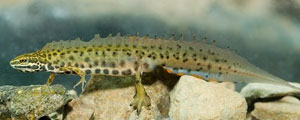 The common newt is less common among us. It is one and a half times smaller than the crested one and has a lighter color, the length of its body together with the tail does not exceed 10-11 cm, the male’s crest at the base of the tail is not interrupted. In terms of lifestyle, both types of newts are very similar, only the common newt perhaps comes to land a little earlier in the summer and goes to winter a little earlier; it is less cold-tolerant than the crested newt.
The common newt is less common among us. It is one and a half times smaller than the crested one and has a lighter color, the length of its body together with the tail does not exceed 10-11 cm, the male’s crest at the base of the tail is not interrupted. In terms of lifestyle, both types of newts are very similar, only the common newt perhaps comes to land a little earlier in the summer and goes to winter a little earlier; it is less cold-tolerant than the crested newt.
We will begin our acquaintance with tailless amphibians with red-bellied toad. This is one of our smallest amphibians: its body length does not exceed 5 cm. It is dark brown on top, and its abdomen is carrot-colored with dark spots. Little toads spend almost their entire lives in water and only spend the winter, as a rule, on land - in burrows, under roots, in deep holes. They prefer old shallow reservoirs with a dark muddy bottom, including small swamps among woody vegetation. Here they reproduce and get their food - beetles, mosquitoes, flies and other small insects.
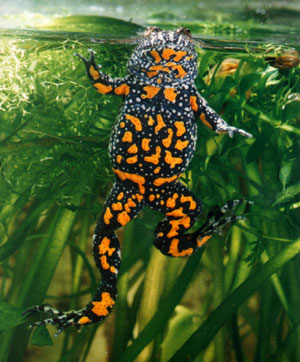 The red-bellied toad has few enemies, since the mucus secreted by its skin glands is poisonous for many animals and greatly irritates the walls of the digestive tract. Some frogs and newts, if placed in one small vessel with fireballs, die quite quickly from their mucus. The bright color of the toad's abdomen seems to be a warning: “don't touch me - I'm poisonous!” Many animals with protective poisonous secretions have similar warning colors.
The red-bellied toad has few enemies, since the mucus secreted by its skin glands is poisonous for many animals and greatly irritates the walls of the digestive tract. Some frogs and newts, if placed in one small vessel with fireballs, die quite quickly from their mucus. The bright color of the toad's abdomen seems to be a warning: “don't touch me - I'm poisonous!” Many animals with protective poisonous secretions have similar warning colors.
Very numerous in rivers, lakes, ponds and other fresh water bodies in our region lake and pond frogs. They are also the largest representatives of amphibians: the pond frog has a body length of up to 10, and the lake frog even up to 15 cm. Brown tones predominate in the color of the upper part of the body of the lake frog, the resonators of the males are dark, and the color of the back of the pond frog is more bright. green, light resonators. Otherwise these species are very similar. The first croaking of frogs in spring can be heard already in early April. At this time, they accumulate in large masses in small reservoirs well warmed by the sun, including temporary puddles, where they lay eggs. Frogs are distinguished by their high fertility: one female lays several thousand eggs (in the toad - up to a hundred, in newts - several hundred). Within a week, tadpoles emerge from the eggs, which after 2-2.5 months turn into frogs.
Frogs get their food both in the water and on the shore near the water. Their food is varied and includes terrestrial and aquatic insects and their larvae, sometimes they eat fish fry and even their fellow tadpoles and frogs, which is more often observed in large lake frogs. Only in ponds where fry of valuable fish are artificially reared can frogs cause some harm; in other natural areas they are certainly useful.
In spring and the first half of summer, pond and lake frogs stay mainly in the water; in the second half of summer and especially in autumn, they are found on the shore near the water and, when in danger, jump into the water. At the end of October or beginning of November, frogs go to the bottom of reservoirs, where they spend the entire winter among plants, under the rhizomes of water lilies and egg capsules, burrowing into the silt.
In the floodplains of the Dnieper, in areas covered with meadow vegetation, you can often find small frogs (6-7 cm), colored light brown, with a slightly yellowish abdomen and a clearly visible black stripe running from the eye to the base of the front leg. This is a sharp-faced frog. Here in the grass she gets food for herself - various insects and their larvae, and immediately hides from enemies. Sharp-faced frogs can be found in water only in the spring during the spawning period; most of them spend the winter at the bottom of reservoirs. They spend the rest of their time on land in damp places and do not go into water. Sharp-faced frogs are especially noticeable at the beginning of autumn - at this time they come out to more open places and often bask in the sun. Already in early or mid-October, earlier than other amphibians, they leave for the winter. Sharp-faced frogs are widespread in more northern regions, and penetrate into our region along the Dnieper valley.
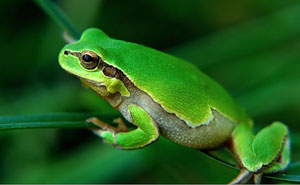 Among the tailless amphibians in our fauna there is one representative of a special family of woodworts, widespread in the forests of the warm zone of all continents. Wood frogs or tree frogs, have suction cups on the tips of their fingers, with the help of which they hold tightly to the branches and leaves of trees and shrubs. Our tree frog is usually colored bright emerald green, has a yellowish belly and throat, but is capable of quite quickly changing color to match the background on which the animal is located. There is a known case where tree frogs living in a terrarium made of fine mesh developed a net-like pattern on their backs. But most often, tree frogs are colored to match the green leaves among which they spend all their time. Only during the breeding season do tree frogs go into the water, where they lay eggs. The development of embryos and tadpoles occurs in water, which usually lasts three months. Tree frogs very cleverly hunt for various insects, spiders, and ticks. They carefully creep up to them, and then with a lightning-fast throw they grab their prey. The cry of a tree frog is similar to a quack or a crack; it can be heard in the floodplains of the Dnieper not only in the spring during the breeding season, but also in the fall before the animals leave for the winter. The tree frog is the smallest amphibian of our fauna: its body length usually does not exceed four centimeters. These cute and very useful animals require special protection and care, because... their numbers are noticeably decreasing.
Among the tailless amphibians in our fauna there is one representative of a special family of woodworts, widespread in the forests of the warm zone of all continents. Wood frogs or tree frogs, have suction cups on the tips of their fingers, with the help of which they hold tightly to the branches and leaves of trees and shrubs. Our tree frog is usually colored bright emerald green, has a yellowish belly and throat, but is capable of quite quickly changing color to match the background on which the animal is located. There is a known case where tree frogs living in a terrarium made of fine mesh developed a net-like pattern on their backs. But most often, tree frogs are colored to match the green leaves among which they spend all their time. Only during the breeding season do tree frogs go into the water, where they lay eggs. The development of embryos and tadpoles occurs in water, which usually lasts three months. Tree frogs very cleverly hunt for various insects, spiders, and ticks. They carefully creep up to them, and then with a lightning-fast throw they grab their prey. The cry of a tree frog is similar to a quack or a crack; it can be heard in the floodplains of the Dnieper not only in the spring during the breeding season, but also in the fall before the animals leave for the winter. The tree frog is the smallest amphibian of our fauna: its body length usually does not exceed four centimeters. These cute and very useful animals require special protection and care, because... their numbers are noticeably decreasing.
In the Lower Dnieper sandy arena lives a little noticeable amphibian - common spadefoot. It is active only at night, and during the day it hides in deep burrows. The spadefoot has a body length of 6-7 cm, a convex forehead and is colored dirty green with dark spots.
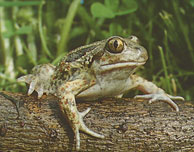 After sunset, when the heat subsides, spadefoot moths leave their shelters to hunt. They feed on grasshoppers, various beetles, caterpillars and other animals, including many pests. Before sunrise, having “bathed” in the pre-dawn dew and thus replenishing water reserves in the body (the skin of all amphibians absorbs water like a sponge), spadefoot spadefoots climb into burrows, where during the day the air is always more humid and the temperature is lower than on the surface. This way of life allows spadefoots to live in the dry sandy steppe far from bodies of water. Here they spend the winter in burrows. And only early spring Spadefoot spadefish move into the water for a short time to lay eggs.
After sunset, when the heat subsides, spadefoot moths leave their shelters to hunt. They feed on grasshoppers, various beetles, caterpillars and other animals, including many pests. Before sunrise, having “bathed” in the pre-dawn dew and thus replenishing water reserves in the body (the skin of all amphibians absorbs water like a sponge), spadefoot spadefoots climb into burrows, where during the day the air is always more humid and the temperature is lower than on the surface. This way of life allows spadefoots to live in the dry sandy steppe far from bodies of water. Here they spend the winter in burrows. And only early spring Spadefoot spadefish move into the water for a short time to lay eggs.
The development of the embryo and larvae lasts about four months, after which young, fully formed spadefoots settle over long distances from their place of birth. At this time - usually at the end of July - they can sometimes be seen after sunset, in large groups, galloping away from the nearest body of water.
Widely distributed in our area green toad, it can be found in fields and gardens, in tree and shrub plantations and in the steppe; This is the only species of our amphibians that likes to settle in populated areas near humans. The toad has highly keratinized, “warty” skin, the dorsal side is colored dirty green, and the abdomen and throat are grayish.
Its dimensions usually do not exceed 10 cm, although sometimes larger (older) specimens are found. Toads have well-developed lungs, and skin respiration is less important than in other amphibians. Like spadefoots, toads are nocturnal, and during the day they hide in holes, under stones, in pits, cellars and other secluded places with high humidity and relatively low temperatures. Thus, toads turn out to be well adapted to life on land.
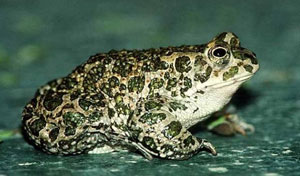 In April, after waking up, the toads begin to reproduce. To lay eggs, they use various bodies of water and very often temporary puddles. The fertility of toads is very high: one female lays up to ten or more thousand eggs. Such high fertility is explained by the fact that toads have a lot of eggs and especially tadpoles, which die in drying up puddles before the end of development, although the development of the embryo and tadpole in them is much faster than in other amphibians, and lasts a little more than two months. As soon as small toads develop limbs, they rush to leave water bodies and move to land, where the toads feel safer and where there is plenty of food for them.
In April, after waking up, the toads begin to reproduce. To lay eggs, they use various bodies of water and very often temporary puddles. The fertility of toads is very high: one female lays up to ten or more thousand eggs. Such high fertility is explained by the fact that toads have a lot of eggs and especially tadpoles, which die in drying up puddles before the end of development, although the development of the embryo and tadpole in them is much faster than in other amphibians, and lasts a little more than two months. As soon as small toads develop limbs, they rush to leave water bodies and move to land, where the toads feel safer and where there is plenty of food for them.
Green toads are usually active until the beginning of November, and then go to winter, hiding deep in holes, holes and other places where frosts cannot reach them. They often winter in groups of up to a dozen or more.
Toads are very voracious. They feed on various insects, slugs, worms and other small animals, among which there are many pests of fields, gardens and vegetable gardens; in populated areas they often eat cockroaches and flies, and like to hunt under street lamps, where masses of nocturnal insects flock. In many countries, there is a custom of bringing and releasing toads into gardens and personal plots to control pests. Toads are also especially valuable because they hunt for nocturnal insects when the main consumers of pests, birds, are sleeping.
In the northern regions of our region, another species is very rarely found - common toad. It settles in ravines and other relatively damp places overgrown with trees and shrubs. Its biology has a lot in common with the green toad. The common toad is distinguished by its larger size, dark brown coloration of the back and even more “warty” skin.
It was said above that all our amphibians need water for reproduction, where they lay their eggs and where embryos and larvae develop. But after spawning ends, many of them live and get their food in various places. Here we can highlight three environmental groups. The first is aquatic forms, which includes the toad, the second is semi-aquatic, these include lake and pond frogs, and the third is terrestrial forms, which is represented by the sharp-faced frog, spadefoot and toads, as well as the tree frog, which is sometimes classified as a special group of arboreal amphibians. Newts lead an aquatic lifestyle in the first half of summer, and then switch to a terrestrial existence, leaving water bodies until spring. The best adapted amphibians for a terrestrial lifestyle are the spadefoot and toads, which can live in dry steppes and even in shifting sand, as long as there is food.
REPTIENTS
Reptiles living within our region belong to three orders: cryptonecked turtles - 1 species, lizards - 4 species and snakes - 6 species. Evgeniy Roman writes about this in his article.
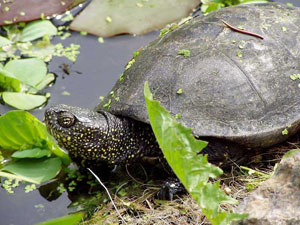 Swamp turtle- a common, although not numerous, inhabitant of the Dnieper flood plains is found in lakes, swamps, and in quiet backwaters of rivers and streams. Loves reservoirs with well-developed aquatic and surface vegetation, overgrown with trees and bushes along the banks. If you carefully approach such a body of water, you can notice turtles resting on the trunks of trees fallen into the water, hummocks or steep coastal slopes. At the slightest disturbance, animals dive and hide at the bottom of reservoirs. In the swamp turtle, the toes are connected by a swimming membrane, so that only the sharp and rather large claws remain free, which they use when they climb out onto snags, steep banks and hummocks and when they dig holes for laying eggs. Swimming membranes help turtles move quickly in the water.
Swamp turtle- a common, although not numerous, inhabitant of the Dnieper flood plains is found in lakes, swamps, and in quiet backwaters of rivers and streams. Loves reservoirs with well-developed aquatic and surface vegetation, overgrown with trees and bushes along the banks. If you carefully approach such a body of water, you can notice turtles resting on the trunks of trees fallen into the water, hummocks or steep coastal slopes. At the slightest disturbance, animals dive and hide at the bottom of reservoirs. In the swamp turtle, the toes are connected by a swimming membrane, so that only the sharp and rather large claws remain free, which they use when they climb out onto snags, steep banks and hummocks and when they dig holes for laying eggs. Swimming membranes help turtles move quickly in the water.
During the entire cold season (about five months), marsh turtles hibernate. In the spring, usually at the end of March or early April, when the weather is relatively warm and the sun is already warming well, turtles awaken from their winter torpor. At this time, they are especially willing to take “sunbathing” and therefore often catch your eye. When it becomes summer-like, the turtles begin laying eggs. At this time, they move tens or even hundreds of meters away from the shore in search of dry places well warmed by the sun. The female, before laying eggs, digs a pear-shaped hole up to 10 cm deep, moistens it with water brought in special anal bladders, and then freezes over the hole, retracting her head under the shell. The oviposition process itself takes place very quickly - just a few minutes, and at the bottom of the hole there are 5-6, and sometimes up to ten white eggs, shaped like large oak acorns, covered with a white shell.
Then the female covers the eggs with soil, compacts and “smoothes” the soil with her lower shell, so the place where the eggs are laid becomes invisible. This is where all care for the offspring of turtles ends. One female makes 2-3 clutches during the summer. The duration of incubation depends on the temperature: the warmer it is, the faster the embryo develops. In hot and dry weather, the first young turtles appear at the end of July - beginning of August, that is, 2-2.5 months after laying eggs. At the end of summer and at the beginning of autumn, baby turtles move from their nesting holes to bodies of water; True, some of them (those that hatched late) remain in their burrows for the winter and enter water bodies only in the spring.
Swamp turtles feed on a variety of small aquatic and water-living animals: mollusks, worms, insects and their larvae, crustaceans, sometimes tadpoles and small fish. Adult turtles are reliably protected from enemies by a strong shell, but eggs and young turtles often become prey for foxes, raccoon dogs and other small predators. People cause great damage to both adult and young turtles when they catch them and bring them home, seemingly with good intentions - to support these cute and harmless animals. Once in an environment that is foreign to them, turtles sooner or later die. Human “love” turns into tragedy for them.
In late autumn, swamp turtles bury themselves in the silt at the bottom of reservoirs, pull their head, tail and limbs under their shell, and spend the entire winter in a state of torpor, only to begin active life again in the spring. Swamp turtles become sexually mature at 6-7 years of age. They live for a very long time: several dozen, and some specimens up to hundreds of years.
In the fauna of our region, the most numerous lizards are foot and mouth disease is colorful and fast. As for the other two species - the Crimean and green lizards, they are found very rarely in our country: the first lives in small numbers in the Belozersky and Berislavsky regions of our region, and the green lizard has so far been found only on the island of Dzharylgach.
There are many lizards in biology common features. These are very active diurnal animals; they love dry, well-lit places covered with herbaceous vegetation or sparse trees and shrubs; they avoid damp areas of floodplains and do not live permanently in cultivated fields of grain crops; some species are found in orchards and vineyards and in shelterbelts. It feeds mainly on insects.
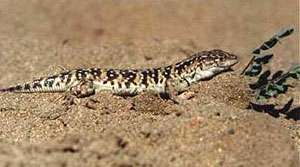 Foot-and-mouth disease multi-colored. This is the smallest of our lizards: the length of which usually does not exceed 12-13 cm, half of which is on the tail. The favorite habitats of multi-colored foot-and-mouth disease are the Lower Dnieper sands, covered with sparse herbaceous vegetation, as well as young pine plantings on these sands; It does not avoid bare sand dunes; it is numerous on the Kinburn Spit.
Foot-and-mouth disease multi-colored. This is the smallest of our lizards: the length of which usually does not exceed 12-13 cm, half of which is on the tail. The favorite habitats of multi-colored foot-and-mouth disease are the Lower Dnieper sands, covered with sparse herbaceous vegetation, as well as young pine plantings on these sands; It does not avoid bare sand dunes; it is numerous on the Kinburn Spit.
Already in early April, as soon as the spring sun warms up, they awaken from winter hibernation. At this time, they can often be seen basking in the sun near their burrow, where they quickly hide at the slightest danger. They spend the night in burrows, and in cloudy, cool weather they also sit during the day. The activity of foot and mouth disease increases with the onset of warm days. On his hunting area, which covers an area of up to two hundred square meters, one foot-and-mouth disease has up to a dozen or more small burrows and other shelters where it hides in case of danger. In this area, the animal obtains food for itself - ants, grasshoppers, small beetles, caterpillars, grass bugs and other insects, immediately the females lay 2-4 eggs in the forest, from which after 1.5-2 months young hatch, about 3 cm foot and mouth disease. In mid-October, and in very warm weather and later, foot and mouth diseases go deep into burrows for the winter.
Fast lizard. The body length usually does not exceed 20-23 cm (larger specimens are very rare), and 2/3 is the tail. In our region, sand lizards live in areas with well-developed herbaceous vegetation, in shelterbelts and other tree and shrub plantings; shifting sands with sparse vegetation are avoided, therefore they are almost never found together with multi-colored foot-and-mouth disease. Sandy lizards have a very diverse coloring, and males are green or mixed with green, and females are dark gray, light brown or brown with various dark spots, stripes and other patterns; sometimes there are lizards of the same color without spots. The large, bright green male sand lizards are sometimes confused with green lizards. (In green lizards, the throat is colored bluish, especially bright in males, they have relatively long tails, and, as mentioned above, they are found here very rarely in limited places).
Agile lizards awaken early from hibernation: often already at the end of March they can be found basking in the rays of the spring sun. True, at this time they are inactive, hardly feed, and when cold weather sets in, they go into holes. Already in mid-May, lizards begin breeding. The female usually lays 6-8 eggs in a shallow hole and covers them with earth. Under the influence of natural heat and sunlight, the embryo develops, which lasts about two months. In mid-July, the first young lizards, about 4 cm long, appear. Lizards feed mainly on grasshoppers and beetles, and less often eat other small invertebrate animals. In October they go into hibernation.
All lizards are very useful animals and deserve every possible protection.
From the squad snake We have 6 species, 5 of which are representatives of the snake family and 1 of the viper family.
Already ordinary. This is a medium-sized snake (large ones are up to a meter or a little more in length) - the most common species in our fauna. In the floodplains of the Dnieper, in the steppe, where there are at least small reservoirs or wet lowlands, on the outskirts of populated areas - everywhere you can find an ordinary grass snake, which can be easily distinguished from other snakes by its yellow temporal spots. It crawls quickly on land, among thick grass and bushes, and swims and dives well.
The favorite food of ordinary snakes are various amphibians, both adults and their larvae (tadpoles), they also eat mice, large insects, and sometimes small fish. They get their food both on land and in water. Such a varied diet allows snakes to live in different places.
Snakes awaken from hibernation in early April and immediately become very active and active. In the spring, before breeding begins, grass snakes molt. Like all snakes, they first grow a horny cover, and then the old skin peels off, from which the animal crawls out, like from a stocking, turning it inside out. The transparent horny scales covering the eyes are also replaced with new ones. At the end of May, snakes begin to breed. The female lays her eggs, of which there are from 10 to 20 or even more, in heaps of rotting plants or manure, where the temperature is always higher and more constant than in the air. This apparently explains the faster development of the embryo of snakes compared to other reptiles. Young cones are born within a month, grow quickly and double in size by autumn.
Snakes usually overwinter in deep rodent burrows, under old stumps and in other shelters, and one shelter is used by a whole group of snakes living in the neighborhood.
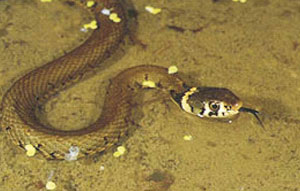 Already aquatic. It differs from the ordinary one, primarily in details of coloration, as well as habitat. It does not have yellow temporal spots; the color of our water snakes varies.
Already aquatic. It differs from the ordinary one, primarily in details of coloration, as well as habitat. It does not have yellow temporal spots; the color of our water snakes varies.
In sea bays, snakes with a single-color dark gray olive or even black color are more often found. In the floodplains of the Dnieper, water snakes are brown in color with a copper-red tint and clearly defined black spots on the back, located in checkerboard pattern, and monochromatic ones are much less common. Water snakes are so called because they are closely associated with bodies of water. In the water they get their main food - small fish, as well as newts, frogs and their larvae, rest on the shore near the water and then lay eggs on higher ground and well-warmed by the sun. When in danger, they always try to go into the water, where they can hide for a long time at the bottom or among algae. Water snakes overwinter in deep burrows or under tree roots in small groups, often several hundred meters from the reservoir.
copperhead. It is less common in our area than grass snakes, maximum dimensions- 60-70 cm. The body is dark gray or brownish with a copper-red tint, which is especially pronounced on the belly in males. Prefers dry steppes and thickets of bushes, avoids water. The copperhead is a very mobile, dexterous snake. In spring and autumn it is active all day, and in summer, when it is hot, it goes hunting in the morning and before evening; when pursued by a person, the copperhead first hides, squeezing into a tight ball, and then actively defends itself and tries to bite. This aggressiveness, apparently, is the reason why many consider the copperhead to be a dangerous snake, although its bite is completely harmless to humans.
Copperheads feed mainly on lizards, as well as mouse-like rodents, locusts and other large insects. By destroying agricultural pests, it brings benefits.
The copperhead belongs to the so-called ovoviviparous animals.
The female does not lay eggs outside, but carries them in the oviducts until the embryo is fully developed. Young copperheads are hatched either while still inside the mother’s body or, more often, at the time the eggs are released. The development of the embryo occurs only due to the nutrients of the egg. This method of reproduction has some advantages compared to laying eggs in external environment. First of all, the eggs are safer and in relatively constant conditions; it is also important that the female finds a more favorable temperature, can bask in the sun, etc.
Yellow-bellied and four-striped snakes. These are our largest snakes: their body length reaches two meters (there is a known case of a four-striped snake 207 cm long being caught on the Kinburn Spit) and both of them are often called “yellow-bellied”, although this name refers only to the first species. Snakes are very agile snakes; they move quickly on the ground, among thick grass and bushes, and the four-striped snake very deftly climbs trees and easily moves along branches.
Awakens from hibernation in mid-April. They are active during the day, and at night they climb into holes and other shelters. At the beginning of June, the snake lays up to a dozen rather large (about 5 cm) oblong eggs under leaves and piles of dry grass, from which young ones hatch after 2-2.5 months.
In our region, yellow-bellied snakes are found more often on the right bank of the Dnieper, and there are especially many of them along the banks of the river. Ingulets, in old quarries, along ravines and gullies overgrown with bushes.
The yellow belly differs from its fellow species by the monochromatic dark gray color of the dorsal side of the body and the bright yellow, almost orange, belly. The head scutes are yellow-brown or beige in color. The yellow-bellied snake is a very aggressive snake, it boldly attacks a person, even chases him, trying to bite him, although his bite is not dangerous: snakes do not have poisonous glands. They feed on mouse-like rodents, gophers, lizards, toads, large insects, bird eggs and other animal food.
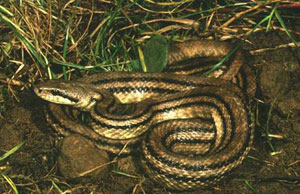 Four stripe runners They are distributed mainly in the left bank part, where they occupy forest groves, depressions, overgrown with bushes; there are quite a lot of them on the Kinburn Spit, in the grove forests of the Black Sea Nature Reserve. The color of the upper part of their body is heavy yellow with dark spots on each scale; in addition, there are large, almost black, blurry spots on the back and sides; the belly is light yellow. Four-striped snakes feed on a variety of animals, but during the nesting period of birds they switch to feeding on eggs and chicks, and they destroy bird nests both on the ground and in trees. They cause great damage to starlings nesting in birdhouses, and sometimes climb into chicken coops for eggs. In contrast to yellow-bellies, they are not aggressive and always try to hide somewhere from their pursuer.
Four stripe runners They are distributed mainly in the left bank part, where they occupy forest groves, depressions, overgrown with bushes; there are quite a lot of them on the Kinburn Spit, in the grove forests of the Black Sea Nature Reserve. The color of the upper part of their body is heavy yellow with dark spots on each scale; in addition, there are large, almost black, blurry spots on the back and sides; the belly is light yellow. Four-striped snakes feed on a variety of animals, but during the nesting period of birds they switch to feeding on eggs and chicks, and they destroy bird nests both on the ground and in trees. They cause great damage to starlings nesting in birdhouses, and sometimes climb into chicken coops for eggs. In contrast to yellow-bellies, they are not aggressive and always try to hide somewhere from their pursuer.
Steppe viper. The only poisonous snake in our fauna.
She has special poisonous glands on the sides of her head, the ducts of which open at the base of her poisonous teeth, which have a canal inside. With the help of these teeth, the poison is injected into the wound of the bitten animal and quickly spreads through the blood throughout the body. The bites of our viper are very painful for humans, but there are no known deaths from the effects of their venom, although the venom of the small animals that vipers feed on subsides within a few minutes.
The number of steppe vipers in our region is continuously decreasing, even on the territory of the Black Sea Nature Reserve, where in the recent past they were very numerous. They are not found at all on cultivated lands; they are not found in the floodplains of the Dnieper, since they do not like damp, dark places.
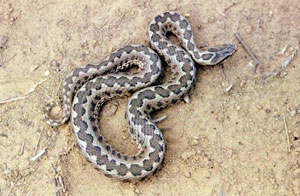 Steppe vipers are inactive; when pursued, they try to hide in some kind of shelter. They awaken from hibernation early, with the onset of the first warm days, and the timing of their first spring appearance depends on the weather; the same can be said about the timing of hibernation. They feed on various small animals: mice, lizards, chicks and eggs of small birds, beetles, grasshoppers, etc., but most of all they eat insects and mouse-like rodents, especially when they appear in large numbers.
Steppe vipers are inactive; when pursued, they try to hide in some kind of shelter. They awaken from hibernation early, with the onset of the first warm days, and the timing of their first spring appearance depends on the weather; the same can be said about the timing of hibernation. They feed on various small animals: mice, lizards, chicks and eggs of small birds, beetles, grasshoppers, etc., but most of all they eat insects and mouse-like rodents, especially when they appear in large numbers.
Vipers are viviparous snakes. Females carry their testicles for 3.5 months in the oviducts, from which vipers about 15 cm long emerge at the end of summer; There are up to ten or more of them, but more often there are 4-8. Young vipers differ from old ones not only in size, but also in darker color or brownish tint. Adult steppe vipers are colored gray and have a clearly defined dark zag-zag line along the back. Their sizes usually do not exceed 40-45 cm. It is interesting to note that steppe vipers living on the islands of the Black Sea Nature Reserve, where colonies of thousands of gulls and other birds nest, are very large in size (more than 60 cm), heavy in weight and twice as fertile (up to 28 eggs per female). Steppe vipers, as useful animals, deserve friendly treatment and protection.
All our reptiles can be divided into two ecological groups: aquatic and terrestrial. The aquatic species include the marsh turtle and the water snake, and the terrestrial species include all other species. The common snake feels equally good on land and in water, but most often obtains food in water.
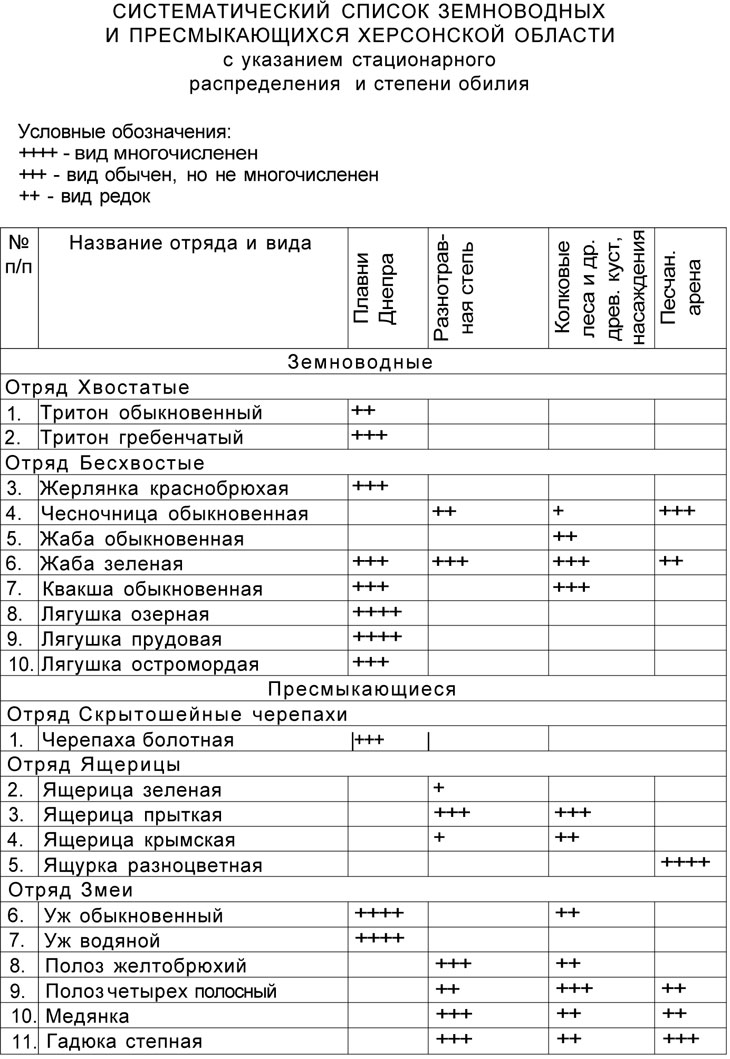
If you find an error, please highlight a piece of text and click Ctrl+Enter.
No related materials found
Queenofwitches / Aug 18 2013, 18:10:18
Please give 5 examples of sentences with participial phrases (they should be constructed differently) And 6 sentences with participial phrases (and theymust be built differently)!
Asem99 / May 15, 2013, 0:19:02 AM
Indicate the option in which the letter I is written at the place of the pass: a) in the fresh air b) Spring sun c) inlong road g) and winter... m morning
Indicate the option in which the letter E is written in the blank space:
a) in the nomon of the building... b) talk about autumn....
c) was in the muse... d) mysteries of history...
Please indicate the option where the error was made:
a) a fashionable muffler b) a beautiful necklace
c) pink flamingo d) in the theater lobby
Indicate the option in which the noun is presented:
a) two b) two c) second d) two
Indicate the option in which the word is not the same root in relation to other words:
a) anhydrous b) water c) lead d) dehydrate
Natashanik228 / Aug 29 2014, 11:19:24
November is the month of struggle between autumn and winter, during which cold and snow alternate with periods of warmth and bad weather. Although it is believed that winter is coming into its ownright already at the beginning of November, the return of heat occurs in the third ten days of the month.
According to the November signs, one can partly predict what the coming winter and the future harvest will be like, since these signs are, apparently, connected with each other and obey laws, the key to which, perhaps, will be given by study and comparison folk signs with scientific observations.
From observations for December it follows that a cold and snowy December, with frequent frosts and winds, is considered normal, and therefore favorable.
Since the winter solstice (from the twenty-second of December) there has been an increase daylight hours, although at first it can be very unnoticeable. In the following days, throughout December and even throughout the winter, frost is especially observed, which is considered a harbinger of the harvest. If the days and nights are clear and the sky is starry, and the weather is cold, you can expect a prosperous year for people.
find an impersonal offer
Gelya200420 / Jan 15 2014, 1:42:59
“Language has... words. Language has... grammar. These are the ways that language uses to construct sentences." L.V.UspenskyHelp me write an argumentative essay
Darkness has attracted and frightened us since childhood. When we are still very young, we already realize that we live in two worlds - a world of light and darkness. Visible and audible white day and hidden impenetrable night. The time will come when we will passionately want to know what is hiding in the darkness. We promise ourselves not to sleep and in the middle of the night we cautiously look out from under the blanket. Everything is this and that, everything is so and not! Silence, things whisper and glance at each other. Oh, how scary and... interesting. The first secret in life...
Two lands: the land of the day and the land of the night. And you can travel through them, like across different continents. On the night continent there are completely different inhabitants, different events, different flowers open there and different butterflies flutter. Unfamiliar night voices are heard, unfamiliar smells float. Everything is different: the sky is not blue, the clouds are not white, the grass and leaves are not green. And even the clear water of the native river suddenly becomes black and mysterious. And it is not the sun that is reflected in it, but the moon. Two worlds: the solar world and the lunar world. A world of noise and a world of silence.
I discovered the night as a country where I had never set foot. This is where the flying squirrels have taken us!
A world of silence...
The silence of the night is deceptive. The night forest is not silent. And even if it seems that there is cosmic silence all around, then this is only for your weak human ear. Look at the dog: every now and then she turns her head and moves her ears. And there are ears that are even more sensitive! For those who hear sounds with a vibration frequency of more than 15,000 per second, there is no night silence at all: for him, the night may be screaming, screaming and yelling! The night grumbles, growls and roars. And we, hard of hearing, are like deaf grouse among all these screams and roars. It’s as if we have plugged our ears, we smile blissfully: what silence there is around...
Sooner or later - but inevitably! - you will want to know where forest birds spend the night in winter. Winter nights seem very scary to us - there, outside the window of our warm room. It is impossible to even imagine how one can endure a night without a roof and without fire. Where do birds hide, what do they see and hear during the long winter night?
And then you find out that sparrows spend the night under the fence, pigeons - in attics. Tits sometimes appear in dense junipers, woodpeckers in hollows. And black grouse and hazel grouse even under the snow!
What if you spend the night with the birds? To fully understand and feel everything? But how? You can’t squeeze into their hollow, you can’t lie under the snow. And yet it was possible.
Somehow I didn’t make it to the house before dark and decided to spend the night on the winter road - a well-trodden sled road. I trampled the snow on the side of the road, laid thick spruce branches, climbed into sleeping bag and began to wait for the morning.
At dusk, a lively group of white buntings flew onto the road and sat down in a row on the ice ridge. They chirped, wiggled their noses, calmed down, fluffed their feathers and hid their noses in them. We sleep on equal terms: only I am in a cotton sleeping bag, and the snow buntings are in feather ones.
White birds are almost indistinguishable on the white road. And the darkness that came hid me too. We don't see each other, and everything will be as if we were alone.
The night has no end in sight! I fell asleep, woke up, did exercises right in my sleeping bag, bending and unbending, stretching my frozen fingers. And I thought: this is where you can extend your life - just one night, but a year long!
The yellow moon, like a lantern, hung on a black spruce tree. Waking up, I noticed that each time the lantern was held by a different tree: the trees passed the moon to each other. At the beginning of the night, the moonlight illuminated the road yellow, and at midnight - greenish. By morning, when the moon disappeared, the road became cold and blue. And at dawn she turned pink.
I don’t know if the snow buntings saw these slow changes in color, but they certainly didn’t sleep through the pink morning road. When the road turned pink, they had already taken their heads out of the feathers on their backs - like from under a blanket. They opened their beaks and chirped; everything around is pink, and they themselves are pink!
They were surprised, turned their noses, took off and flew away. And it was clear from everything that nothing terrible had happened. For them, night is like night. And for me - a year long...
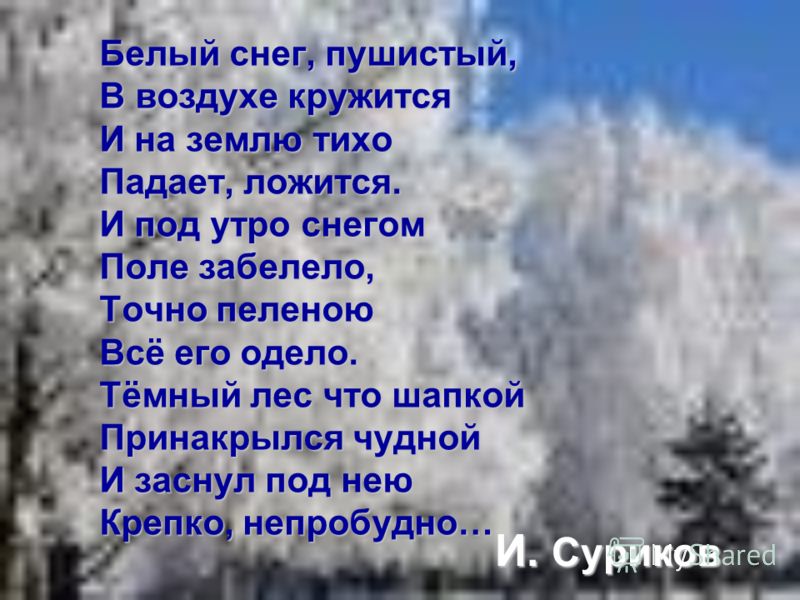
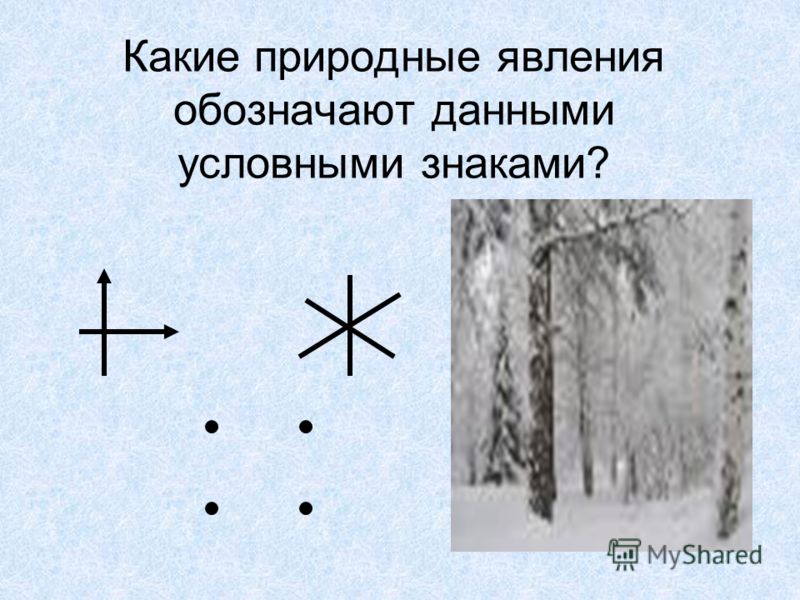

Indicate the stages of winter. It's a very cold time. Time for “pre-terpi- dary spring”. W h i t h T r o p Time. From February 2, 1 to March 2, 0. From January 21st to February 20th. From 2 1 December to 2 0 January. Root winter. First winter. The turning point of winter. winter.
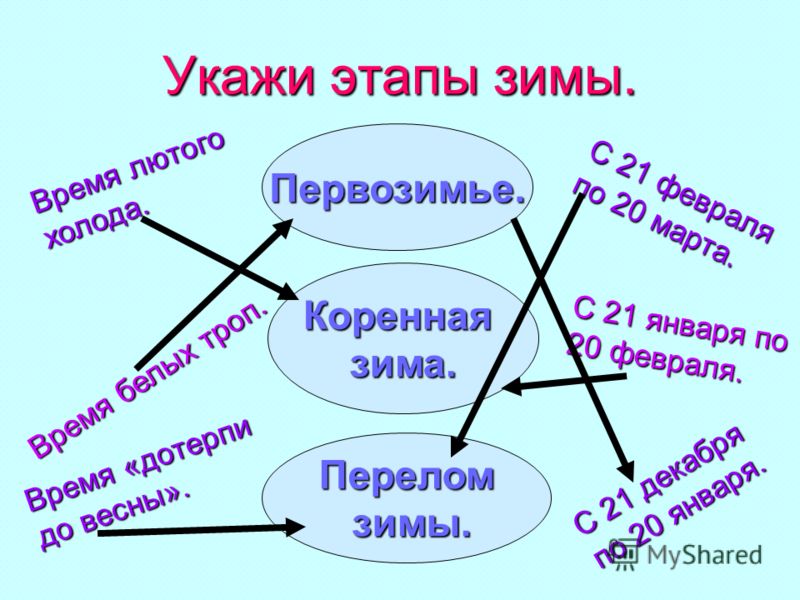
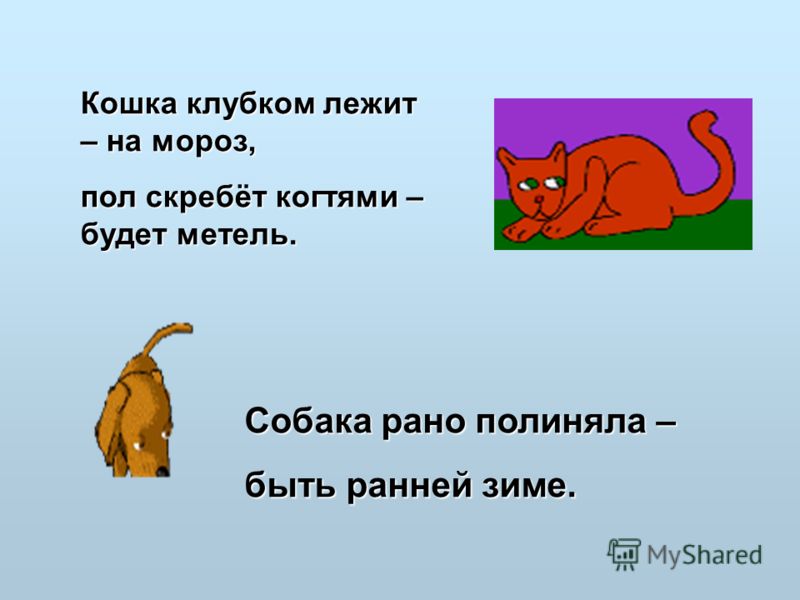
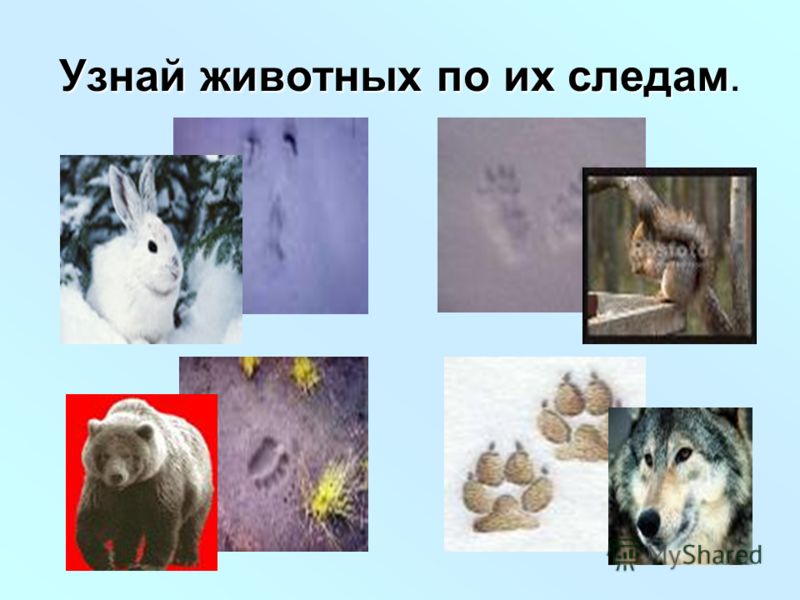
Insert words. Animals winter in different ways. Insects, amphibians, reptiles, which cold blood, for the winter ____________. Some animals take refuge in their _______ and __________ until spring. Other animals exchange their summer ________ for winter ones and run all winter to avoid freezing. But ______ have especially hot blood; they never hibernate. bird fur freezes in burrows and dens
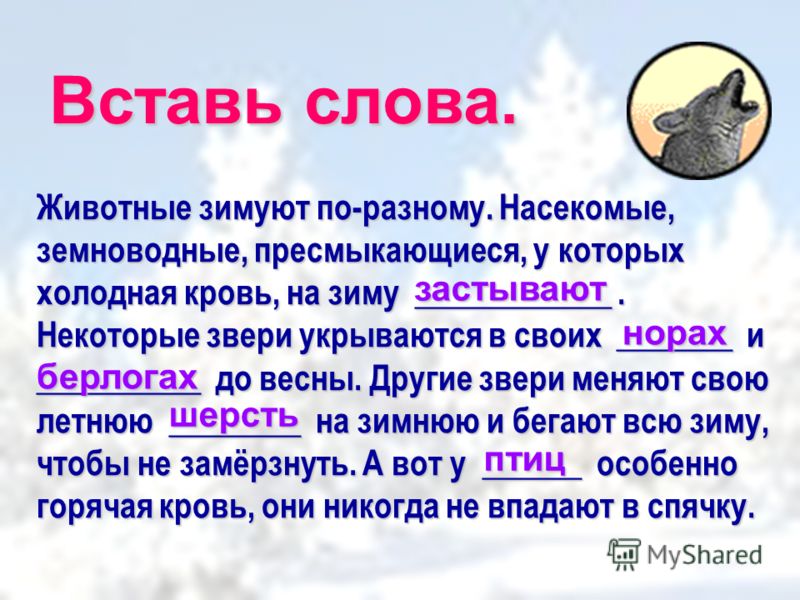
Guess the keyword. 1 R 6 B 24 B 7 C 3 R B YA AK K A 5 1. Who lives for six months without lunch? 2. What animal sleeps for nine months of the year? 3. Who changes their fur coat twice a year? 4. What does moose lose every winter? 5. Which bird has a snowdrift - both a bedroom and a dining room? 6. Who has a “wood” warehouse under the ice? 7. On which tree does the crossbill build its nest in winter? A R S U O N L K O G Y B C H I O B R E L

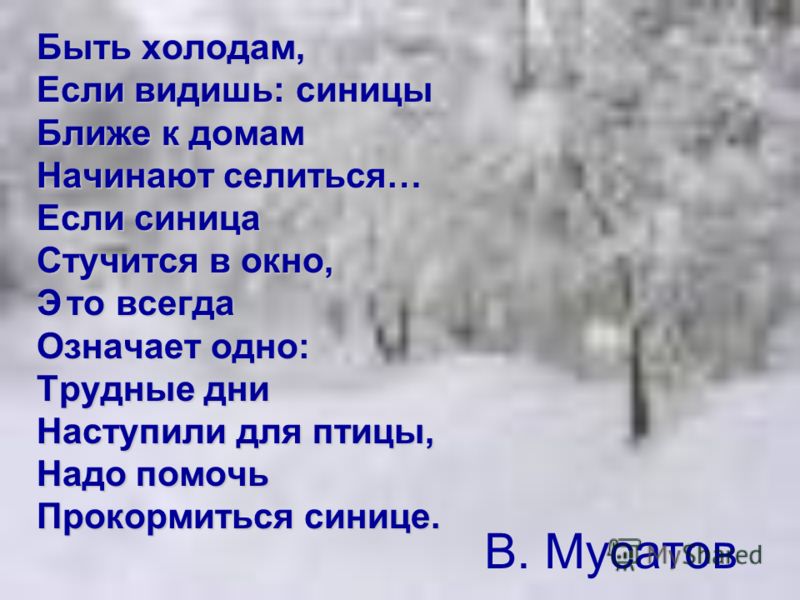
Solve the puzzle. The guys went to the grove and took with them food for the birds: pumpkin seeds, dried rowan berries, a piece of lard and a large cracker. At the edge of the forest they saw flocks of tits and bullfinches, a waxwing and a crow. Think about how the guys divided the treats. Keep in mind: crackers are too heavy for the tit, bullfinches don’t like lard, waxwings love rowan, and the crow is ready to profit from everything.
1. Formation in children of an idea about the life of fish, amphibians, reptiles and insects, their adaptability to seasonal conditions.
2. Teach children to establish cause-and-effect relationships of various types and to make their judgments with evidence.
3. Develop in children the ability to put forward hypotheses and draw conclusions.
4. Foster cognitive interest in nature.
Material: Pochemuchka doll, story “Where frogs spend the winter” “Ecology in pictures”.
Progress of the conversation.
Pochemuchka greets the guys and tells them that he went for a walk to the lake. It was a wonderful winter day, snow was falling, but it was gloomy on the lake. I didn't see any
frogs, no mosquitoes, no flies. The lake was covered with ice and it was very boring. And where have all the insects, frogs, and fish disappeared?
Educator: Guys, do you want to know where the fish, amphibians, reptiles and insects disappeared to?
Listen, I’ll read you the story “Where Animals Winter” from the book “Ecology in Pictures.”
Questions: -How do frogs winter?
Why can't they live on the ground in winter?
That's right, frogs go underwater and spend the winter there, burying themselves in mud or silt.
Pochemuchka: Guys, what will happen to the frog if you dig it out from under the snow and bring it close to the fire?
(she will die from rapid temperature change)
What do frogs eat in winter (they don't eat anything, they sleep)
And if the frog was covered with fur, could it stay through the winter? (a frog cannot have fur, it will overheat).
Could the frog be fluffy? (no, frogs breathe through the entire surface of their skin; in order for a frog to breathe, the skin must always be moist)
Why: I learned everything about frogs, thanks, guys. Where have the insects gone?
Educator: Displays pictures of butterflies, beetles, dragonflies.
Where do butterflies spend the winter? (they fly to the south - cabbages, admirals of thistles) most die before the onset of winter, but the females leave behind clutches of eggs from which caterpillars emerge.
There are also butterflies that do not die, but fall into torpor. These are urticaria, lemongrass, mourning grass. In late autumn, these butterflies climb under fallen leaves, cracks in the roots of old stumps, under the bark of trees and other secluded places.
How do beetles spend the winter? (they sleep in a daze in various shelters - under the bark of stumps, in cracks in tree trunks, in the thickness of wood, etc.)
Where do dragonflies spend the winter? (most dragonflies die after laying eggs in water). There are several species of dragonflies (watchers, great yoke) that fly south.
Pochemuchka: I realized, guys, that most insects fall into torpor, stop feeding, and spend the winter in a state of hidden life. Where do fish spend the winter? (most go into deep winter hibernation)
Who helps the fish survive the winter? (fishermen who make holes cut ice holes)
Why do fish need these windows? (so they can breathe)
Why: -Where did the lizards, snakes, and vipers disappear? Like fish, their body temperature drops to ambient temperature during the cold season. They all hide in various shelters and fall into a stupor there. Lizards climb into cracks in the soil or crevices between stones and rocks. Snakes and vipers crawl into empty rodent holes. Swamp turtles go into the water and spend the winter there, burying themselves in mud or mud.
Educator: Well done! You explained everything very correctly to Pochemuchka. And now I invite you to play.
Didactic game “Insect or amphibian”.
The teacher names insects and amphibians, the children divide them into appropriate groups. At the end they call it a mosquito (this is an amphibious insect)
Didactic game “What does the animal do” (the teacher names the animal, the children say what it can do: fly, jump, run, crawl, swim).
Ecological Center "Ecosystem" you can inexpensive(at production cost) buy(order by mail cash on delivery, i.e. without prepayment) our copyright teaching materials in zoology (invertebrate and vertebrate animals):
10
computer (electronic) determinants, including: insect pests of Russian forests, freshwater and migratory fish, amphibians (amphibians), reptiles (reptiles), birds, their nests, eggs and voices, and mammals (animals) and traces of their vital activity,
20
colored laminated definition tables, including: aquatic invertebrates, diurnal butterflies, fish, amphibians and reptiles, wintering birds, migratory birds, mammals and their tracks,
4
pocket field determinant, including: inhabitants of reservoirs, birds of the middle zone and animals and their traces, as well as
65
methodological benefits And 40
educational and methodological films By methods carrying out research work in nature (in the field).
Anatomy, morphology and ecology of reptiles
12. Annual cycle reptile life
In reptiles it is expressed in the alternation active period in the warm season and torpor (hibernation) during unfavorable periods (winter in temperate latitudes, summer drought in arid regions). The first period is associated with reproduction, growth and settlement of young animals, accumulation of fat reserves necessary to survive the period of torpor. Annual biological cycles are clearly expressed in the inhabitants temperate latitudes, weaker in the subtropics and less noticeable in tropical areas. However, even there, while maintaining activity throughout the year, in each species the breeding season is replaced by a time of sexual rest. Only some tropical and subtropical lizards can lay eggs repeatedly in different months.
Biological cycles can differ significantly not only among different types, but also in individual populations of the same species. Green turtles - Chelonia mydas in the Caribbean Sea lay eggs in May-October, on the island. Ascension - in January-April, and in Ceylon - in July-November.
Reproduction time(oviposition and hatching of young eggs) depend on local conditions and occur on optimal periods - favorable weather and good food opportunities. Thus, Central Asian turtles - Testudo horsfieldi in Central Asia, leaving their wintering shelters in early spring, immediately begin breeding and in May-June, even before the summer drought, the female manages to lay three clutches of 2-6 eggs. From these turtles hatch in August-October, which remain overwintering in the ground and come to the surface only in the spring of next year. In the tropical regions of the Amazon and Orinoco, the tartaruga river shield-footed turtle - Podocnemis expansa breeds in the middle of the dry season. Round-headed lizards in Central Asia begin mating in the fall and some of the females go into the winter fertilized; Mating resumes the following spring.
Duration of active period depends on temperature conditions, precipitation, availability of available food and ability to tolerate adverse conditions. Thus, the common viper, Vipera berus, which penetrates far to the north, falls into torpor later than other reptiles, and becomes active earlier in the spring. The viviparous lizard - Lacerta vivipara in Southern Europe is active for about 9 months a year, in central Russia - about 5.5 months, and in the north even less. The duration of torpor during unfavorable periods is equally different. IN warm winters in the Caucasus and the republics of Central Asia, some snakes and lizards (cotton muzzles, vipers, ephas, foot and mouth diseases, round heads) emerge from winter shelters on warm days. Agamas and geckos living in warm buildings in Central Asia do not fall into torpor at all. In the same places, Central Asian turtles, whose food (lush green vegetation) in deserts and semi-deserts often dries out already at the end of May, are active only in spring and early summer, sometimes no more than three months: before the summer drought they fall into torpor and wake up only the next in the spring - their summer hibernation turns into winter.
Overwinter reptiles in shelters - natural shelters, rodent burrows, their own burrows (rarely). Many species of lizards and snakes hibernate alone, some groups, sometimes in tens and hundreds. For example,



